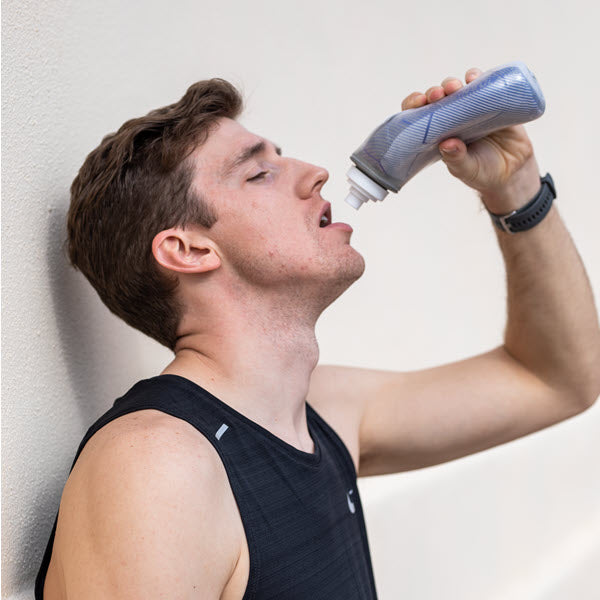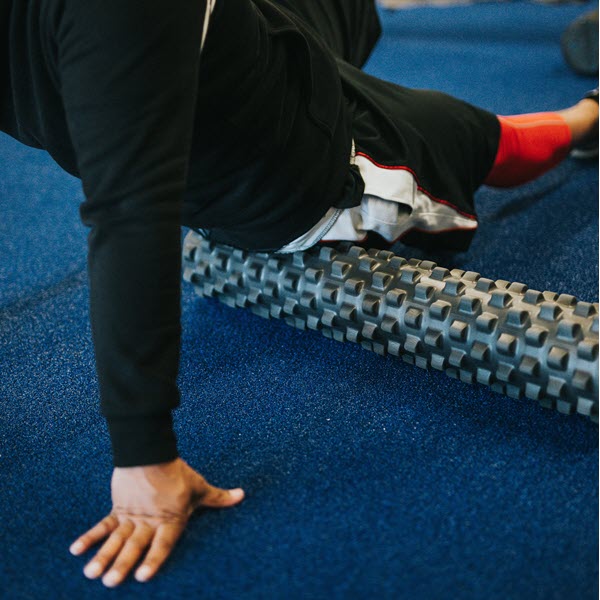What actually causes
muscle cramps?
muscle cramps?
written by: Pratik Patel
We’ve all seen it... The athlete clutching the back of their leg while hobbling along the race course and looking as though they’re about to shed a tear. We also all know what’s happening, but to break it down for you, they’re experiencing an involuntary contraction of their muscle, leading to the dreaded muscle cramp. Muscle cramps during exercise can be very frustrating, unpredictable, and painful to deal with. They’re very common within the athletic community and they sneak up on people both during an activity or during rest and recovery. There are a number of potential factors that can contribute to a muscle cramp, but something to note is that those with a history of cramping are more susceptible to getting one again. Identifying both strategies and the root cause of an athlete’s cramping can be a huge relief and provide an advantage for those training and competing regularly.
It’s commonly believed that dehydration (and specifically electrolyte loss) is a big contributor to cramping and that if you stay hydrated you can actually prevent them from happening. It’s true that sweating during intense and long exercise can lead to dehydration and loss of electrolytes if an athlete is not adequately replenishing. There is also supporting evidence that shows dehydration and electrolyte loss is linked directly to muscle cramps.
Cramping has been shown to happen from dehydration at body mass losses of 2% while the incidence of cramping doubled when 3% dehydration was reached (1). It’s been shown that sodium losses were larger in athletes prone to cramping than those with no history of muscle cramping whatsoever (2), and cramp-prone athletes lose more electrolytes (have higher sweat sodium concentrations) in sweat and have electrolyte levels that tend to decline versus controls (3).
Preventing a greater electrolyte deficit (by hydrating with electrolytes vs. only water) over the course of a training session and choosing the right fluid matters when it comes to preventing or alleviating cramps. It’s been shown that those who are more cramp prone tend to drink water versus drinking an electrolyte sports drink (3). This is crucial when dehydration has already happened as an electrolyte drink can help to maintain your electrolyte levels. Only drinking water can lead to lower serum electrolyte concentrations and increased susceptibility to a cramp after dehydration as opposed to someone who is drinking an electrolyte sports drink (4) and therefore replenishing electrolytes. When only a small amount of dehydration is present (1% body mass loss), consuming an electrolyte drink has also been shown to delay the onset of a muscle cramp by over double. Those experiencing a cramp sweat more than those that did not, showing how electrolyte and fluid consumption can actually delay the onset of a cramp (5).

Not exactly. Yes, dehydration, electrolyte loss, and choice of fluid replenishment can play a role in preventing or delaying muscle cramps, but it doesn’t solve every cramping issue or why there are instances where cramping has still occurred with little to no sweat/electrolyte loss or in cooler environments. Not all published studies show that those experiencing (muscle cramps) are more dehydrated than controls. This has been shown even when dehydration was experienced at a rate of 3-5% body mass loss (and even at >5%) where the risk of a muscle cramp was not changed (6, 7). Results from a number of studies show that those suffering from muscle cramps are not always dehydrated, nor do they have changes in their serum electrolyte levels (8-13).
For some athletes, cramping may be more associated with fatigue as opposed to dehydration and electrolyte losses, but changes in electrolyte concentrations can lead to exacerbating fatigue. Another thoroughly researched theory of why muscle cramps happen revolves around muscle fatigue and what is called ‘altered neuromuscular control’. When muscles are active, especially during intense or longer periods of exercise, they are contracting repeatedly via electrical stimulation of motor nerves (nerves responsible for muscle movement). Excessive or repetitive amounts of muscular contractions have been shown to induce muscle cramps. The theory of altered neuromuscular control explains how muscle fatigue disrupts the stimulation and relaxation of motor nerves. Voluntary muscular contractions are the first element of cramping which can be accelerated by muscle fatigue. Muscle fatigue is associated with an increase in signals being sent to motor nerves (to force contraction) and a decrease in signals (to induce relaxation). Muscles that are being contracted repeatedly (and not allowed to relax) will become susceptible to cramping, even more so during intense training or long duration exercise/training. (8, 14).
Because there can be a large number of factors that can contribute to cramping, fatigue, and altered neuromuscular function (15) it’s better to not focus on an either or approach and start with the most basic areas to address which are nutrition, hydration, and fitness.
⬢ Nutrition (16):
We’ve all been invited to the pre-race pasta dinners, but how much should you actually be consuming? The rule of thumb is ~0.45g of carbs per pound of bodyweight about 1 hour prior to training/exercise for intense training or exercise (this equates to ~80g of carbohydrates for a 180 pound individual, equivalent to 1 large banana and 1 peanut butter and jelly sandwich). During events longer than 60 minutes, 30-60g of carbs per hour should be consumed. When looking at ultra-endurance events of 180 minutes or longer, upwards of 90-120g of carbs per hour should be consumed in order to stay properly fueled and avoid muscle cramping.
⬢ Hydration (17):
To go along with that pre-race pasta dinner, athletes will also be hydrating the best way that they know how. Before the event, athletes should consume 0.08-0.1 ounces of fluid per pound of bodyweight 4 hours prior, and another 0.05-0.08 ounces per pound of bodyweight 2 hours prior. As an example, a 20 pound person should consume 16-2 ounces (0.08-0.1oz/lb) four hours before and another 10-1 ounces (0.05-0.08oz/lb) two hours before. During the race, athletes should consume enough fluids to prevent a 2% decrease in body mass and replenish the electrolytes they’ve lost. Although it’s previously been a guessing game when it comes to electrolyte replenishment, our Hydration Biosensor can now give you accurate and real-time data that informs athletes of exactly how many electrolytes they’ve lost during a workout, making it easier than it’s ever been to stay on top of electrolyte replenishment.
⬢ Fitness:
The less fit you are the more energy you’ll use to maintain a specific work output and the faster fatigue will set in. Being aware of your output is crucial as it has been shown that cramping can occur when performing exercise at a higher intensity or for longer than you are used to when compared to normal training, especially in hot and humid conditions (18). This forces the muscles to contract more and the potential for altered neuromuscular function is greater, especially if sweat rates are higher.
We all know that stretching is the not-so-secret sauce when it comes to fixing a cramp. If you do end up with one, the first thing you can do is to stop, rest, and stretch the affected area which has been shown to be an effective treatment after the development of a muscle cramp (19).
Here’s a sauce that may actually be a secret to most. Another strategy to employ once a cramp has been encountered is to drink pickle juice. Ingesting 0.015 ounces of pickle juice per pound of bodyweight (this equates to 2.7oz of pickle juice for a 180# individual) has been shown to reduce the duration of a cramp more than just water alone (20).
If all else fails, giving the muscle group proper rest (up to 10 minutes) will allow fatigue to subside and stop sending signals to the motor units to fire to normalize neuromuscular control.
So what causes leg cramps while you’re running the 26.2 mile race that you trained all winter for? The cause of muscle cramps can be multifactorial in nature and can be due to dehydration and loss of electrolytes. However excessive fatigue is also a cause as it can lead to altered neuromuscular control. Universal solutions generally do not exist and must be individualized on a case-by-case basis, but having a plan in place to help reduce the risk and alleviate symptoms can be highly beneficial.

(17) American College of Sports Medicine, Sawka, M. N., Burke, L. M., Eichner, E. R., Maughan, R. J., Montain, S. J., & Stachenfeld, N. S. (2007). American College of Sports Medicine position stand. Exercise and fluid replacement. Medicine and science in sports and exercise, 39(2), 377–390.